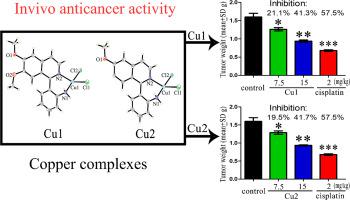Journal of Inorganic Biochemistry ( IF 3.8 ) Pub Date : 2020-09-28 , DOI: 10.1016/j.jinorgbio.2020.111260 Noor Shad Gul 1 , Taj-Malook Khan 1 , Ming Chen 1 , Ke-Bin Huang 1 , Cheng Hou 1 , Muhammad Iqbal Choudhary 2 , Hong Liang 1 , Zhen-Feng Chen 1

|
Two copper complexes, Cu1 (CuL1Cl2, L1 = 2-(6,7-dimethoxyisoquinolin-1-yl) aniline) and Cu2 (CuL2Cl2, L2 = 2-(6-methoxyisoquinolin-1-yl) aniline), were synthesized and characterized. These complexes exhibited high cytotoxic activity toward different cancer cell lines, including the A549 lung cancer cell line, and low cytotoxicity toward normal human cells. Mechanistic studies have shown that these complexes induce bimodal death of cancer cells through apoptosis and autophagy, including the activation of apoptotic and autophagic cell signaling pathways. In addition, Cu1 and Cu2 interacted with calf thymus DNA (ct-DNA) via an intercalative binding mode. The different biological behaviors of these copper complexes could be attributed to the presence of electron-donating methoxy groups on the ligands. Cu1 and Cu2 effectively inhibited tumor growth in a xenografted mouse model bearing A549 cells but exhibited lower in vivo toxicity than cisplatin. Thus, Cu1 and Cu2 can be developed as potential anticancer agents.
中文翻译:

新型铜配合物通过凋亡和自噬诱导A549癌细胞双峰死亡
两种铜络合物Cu1(CuL 1 Cl 2,L 1 = 2-(6,7-二甲氧基异喹啉-1-基)苯胺)和Cu2(CuL 2 Cl 2,L 2 = 2-(6-甲氧基异喹啉-1-基)苯胺)苯胺),进行了合成和表征。这些复合物对包括A549肺癌细胞系在内的不同癌细胞系显示出高细胞毒性活性,而对正常人细胞则显示出低细胞毒性。机理研究表明,这些复合物通过凋亡和自噬(包括凋亡和自噬细胞信号通路的激活)诱导癌细胞双峰死亡。此外,Cu1和Cu2通过插入结合模式与小牛胸腺DNA(ct-DNA)相互作用。这些铜配合物的不同生物学行为可归因于配体上供电子甲氧基的存在。在带有A549细胞的异种移植小鼠模型中,Cu1和Cu2有效地抑制了肿瘤的生长,但与顺铂相比,其体内毒性较低。因此,Cu1和Cu2可以开发为潜在的抗癌药。






























 京公网安备 11010802027423号
京公网安备 11010802027423号